Operations Management and Sustainability
VerifiedAdded on 2020/01/28
|15
|5435
|320
Literature Review
AI Summary
This assignment examines the interconnectedness of operations management, sustainability practices, and organizational performance. It analyzes various academic articles that explore how environmental management, lean manufacturing, and supplier management influence operational outcomes within companies. The focus is on understanding how sustainable practices can contribute to enhanced operational efficiency and overall business success.
Contribute Materials
Your contribution can guide someone’s learning journey. Share your
documents today.
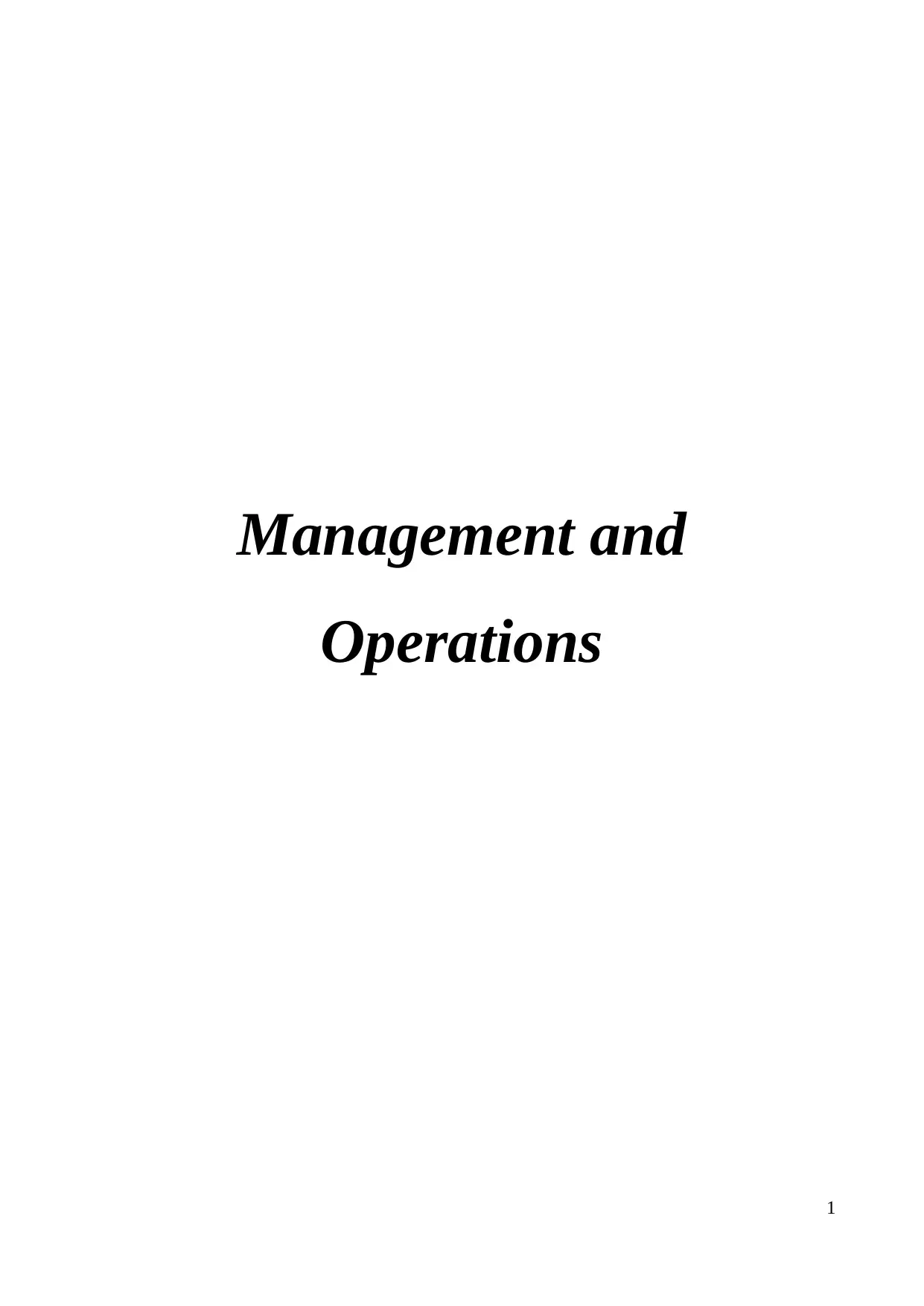
Management and
Operations
1
Operations
1
Secure Best Marks with AI Grader
Need help grading? Try our AI Grader for instant feedback on your assignments.

TABLE OF CONTENTS
INTRODUCTION ...............................................................................................................................3
Task 1....................................................................................................................................................3
a) Definition and comparison of different roles and characteristics of leader and manager...........3
b) Application of role of leader and function of manager in different situations in Ben's cookies 5
c) Theories and models of leadership approach ..............................................................................5
d) Difference between role of leader and function of manager by applying theories and concepts6
e) Strengths and weaknesses of different approaches to situations.................................................7
f) Critical analysis of different theories and approaches to leadership............................................8
Task 2 ...................................................................................................................................................8
a) Key approaches to operation management and role that leaders and managers play..................8
b) Importance and value of operation management in achieving business objectives....................9
c) Factors within business environment which impacts operational management and decision-
making by leaders and managers...................................................................................................10
d) How leaders and managers can improve efficiencies of operational management...................11
e) Different factors affecting business environment and wider community..................................11
f) Critical evaluation of operational management and factors impacting wider business
environment ................................................................................................................................12
CONCLUSION .................................................................................................................................13
REFERENCES...................................................................................................................................14
2
INTRODUCTION ...............................................................................................................................3
Task 1....................................................................................................................................................3
a) Definition and comparison of different roles and characteristics of leader and manager...........3
b) Application of role of leader and function of manager in different situations in Ben's cookies 5
c) Theories and models of leadership approach ..............................................................................5
d) Difference between role of leader and function of manager by applying theories and concepts6
e) Strengths and weaknesses of different approaches to situations.................................................7
f) Critical analysis of different theories and approaches to leadership............................................8
Task 2 ...................................................................................................................................................8
a) Key approaches to operation management and role that leaders and managers play..................8
b) Importance and value of operation management in achieving business objectives....................9
c) Factors within business environment which impacts operational management and decision-
making by leaders and managers...................................................................................................10
d) How leaders and managers can improve efficiencies of operational management...................11
e) Different factors affecting business environment and wider community..................................11
f) Critical evaluation of operational management and factors impacting wider business
environment ................................................................................................................................12
CONCLUSION .................................................................................................................................13
REFERENCES...................................................................................................................................14
2

INTRODUCTION
Operations management(OM) is an area which can not be understood because of its
multifaceted attributes. Operations authority is mainly concerned with devising, organizing and
handling in formulation, producing or furnishing of utility. It involves utilising resources from staff
substantial, equipment or technology. It acquires, develops and deliver better to consumers need and
demands. There are two big terms in operations management: supply chain management and
logistics. Operation management figure out domestics and international movements, demands of
customers and the available resources of creation. It access the recovery of materials and use of
worker on time in cost reasonable manner for meeting expectations of customers (Rademeyer,
Fairweather and et.al., 2010). Level of inventory are monitored to assure more quantities are in
hand. Another important side of operation management is delivering goods to customers. It consists
of making sure that the product are delivered on at time limitations. Operations management also
assure that product is provide to that consumer ,having better quality and functionality. leadership
and development programmes are developed by this present report and for this desire Ben's cookies
company has been taken into account in order to assess the roles of leader and managers.
Moreover, it will shed light upon the importance and value of OM in achieving business targets.
TASK 1
a) Definition and comparison of different roles and characteristics of leader and manager
A guide is a person who influences a bunch of people for accomplishing target. He holds a
ruling or superior position in his field and is capable to exercise a high degree of control or impact
over others.
A manager is an individual who is in charge for particular tasks, or certain subset of a
company. A manager has a staff of employees who report to him.
Basis of comparison Roles and Characteristics of
leader
Roles and characteristics of
manager
Definition Leadership means having the
quality to influence, motivate, and
enable others to put their efforts in
achieving their targets and success
of the organisation in which they
will work.
Management is simply mean
that directing and controlling
one or more than one people or
entities for the motive of
coordinating and harmonising
that group for achieving that
target(Loorbach, 2010).
3
Operations management(OM) is an area which can not be understood because of its
multifaceted attributes. Operations authority is mainly concerned with devising, organizing and
handling in formulation, producing or furnishing of utility. It involves utilising resources from staff
substantial, equipment or technology. It acquires, develops and deliver better to consumers need and
demands. There are two big terms in operations management: supply chain management and
logistics. Operation management figure out domestics and international movements, demands of
customers and the available resources of creation. It access the recovery of materials and use of
worker on time in cost reasonable manner for meeting expectations of customers (Rademeyer,
Fairweather and et.al., 2010). Level of inventory are monitored to assure more quantities are in
hand. Another important side of operation management is delivering goods to customers. It consists
of making sure that the product are delivered on at time limitations. Operations management also
assure that product is provide to that consumer ,having better quality and functionality. leadership
and development programmes are developed by this present report and for this desire Ben's cookies
company has been taken into account in order to assess the roles of leader and managers.
Moreover, it will shed light upon the importance and value of OM in achieving business targets.
TASK 1
a) Definition and comparison of different roles and characteristics of leader and manager
A guide is a person who influences a bunch of people for accomplishing target. He holds a
ruling or superior position in his field and is capable to exercise a high degree of control or impact
over others.
A manager is an individual who is in charge for particular tasks, or certain subset of a
company. A manager has a staff of employees who report to him.
Basis of comparison Roles and Characteristics of
leader
Roles and characteristics of
manager
Definition Leadership means having the
quality to influence, motivate, and
enable others to put their efforts in
achieving their targets and success
of the organisation in which they
will work.
Management is simply mean
that directing and controlling
one or more than one people or
entities for the motive of
coordinating and harmonising
that group for achieving that
target(Loorbach, 2010).
3
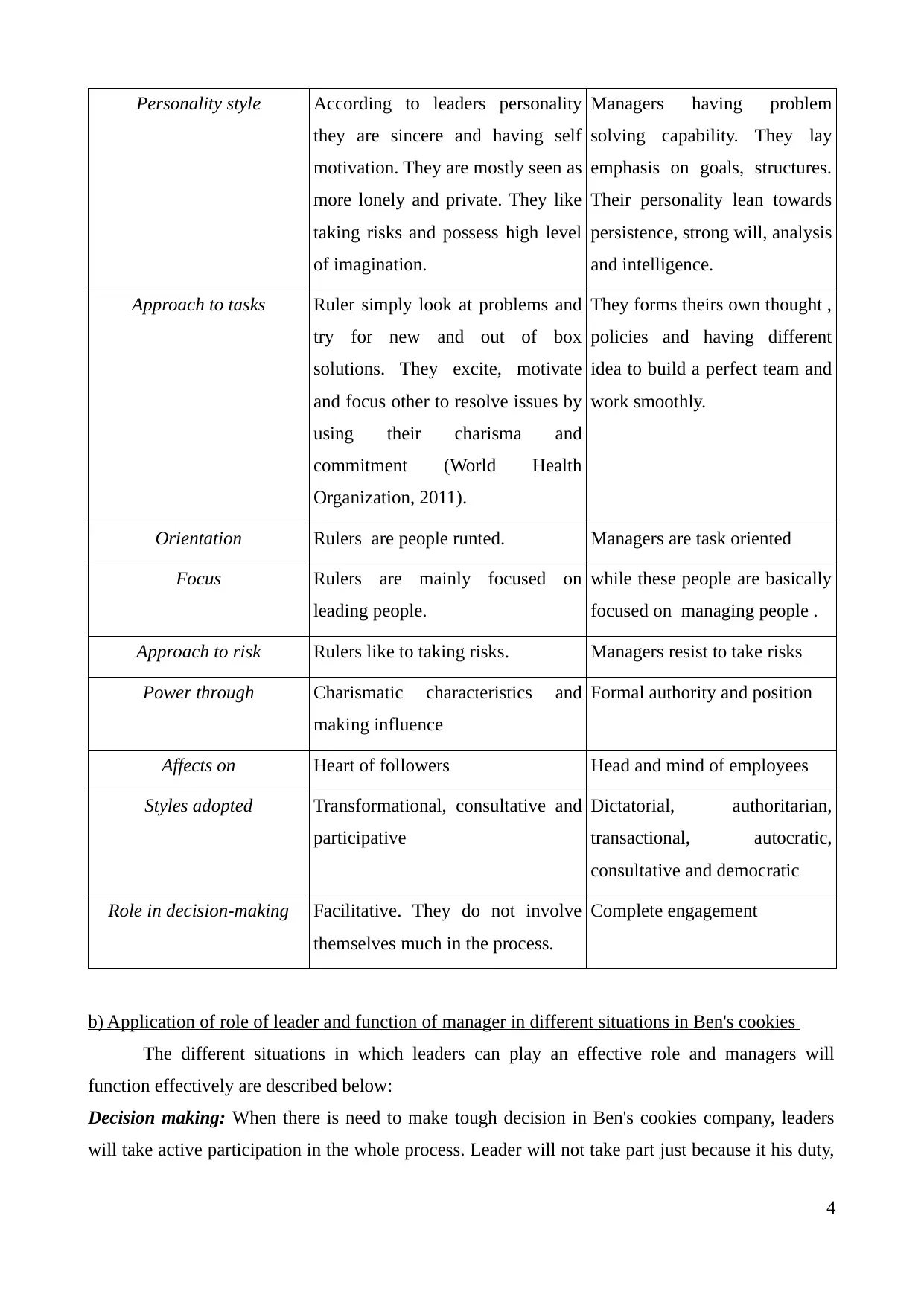
Personality style According to leaders personality
they are sincere and having self
motivation. They are mostly seen as
more lonely and private. They like
taking risks and possess high level
of imagination.
Managers having problem
solving capability. They lay
emphasis on goals, structures.
Their personality lean towards
persistence, strong will, analysis
and intelligence.
Approach to tasks Ruler simply look at problems and
try for new and out of box
solutions. They excite, motivate
and focus other to resolve issues by
using their charisma and
commitment (World Health
Organization, 2011).
They forms theirs own thought ,
policies and having different
idea to build a perfect team and
work smoothly.
Orientation Rulers are people runted. Managers are task oriented
Focus Rulers are mainly focused on
leading people.
while these people are basically
focused on managing people .
Approach to risk Rulers like to taking risks. Managers resist to take risks
Power through Charismatic characteristics and
making influence
Formal authority and position
Affects on Heart of followers Head and mind of employees
Styles adopted Transformational, consultative and
participative
Dictatorial, authoritarian,
transactional, autocratic,
consultative and democratic
Role in decision-making Facilitative. They do not involve
themselves much in the process.
Complete engagement
b) Application of role of leader and function of manager in different situations in Ben's cookies
The different situations in which leaders can play an effective role and managers will
function effectively are described below:
Decision making: When there is need to make tough decision in Ben's cookies company, leaders
will take active participation in the whole process. Leader will not take part just because it his duty,
4
they are sincere and having self
motivation. They are mostly seen as
more lonely and private. They like
taking risks and possess high level
of imagination.
Managers having problem
solving capability. They lay
emphasis on goals, structures.
Their personality lean towards
persistence, strong will, analysis
and intelligence.
Approach to tasks Ruler simply look at problems and
try for new and out of box
solutions. They excite, motivate
and focus other to resolve issues by
using their charisma and
commitment (World Health
Organization, 2011).
They forms theirs own thought ,
policies and having different
idea to build a perfect team and
work smoothly.
Orientation Rulers are people runted. Managers are task oriented
Focus Rulers are mainly focused on
leading people.
while these people are basically
focused on managing people .
Approach to risk Rulers like to taking risks. Managers resist to take risks
Power through Charismatic characteristics and
making influence
Formal authority and position
Affects on Heart of followers Head and mind of employees
Styles adopted Transformational, consultative and
participative
Dictatorial, authoritarian,
transactional, autocratic,
consultative and democratic
Role in decision-making Facilitative. They do not involve
themselves much in the process.
Complete engagement
b) Application of role of leader and function of manager in different situations in Ben's cookies
The different situations in which leaders can play an effective role and managers will
function effectively are described below:
Decision making: When there is need to make tough decision in Ben's cookies company, leaders
will take active participation in the whole process. Leader will not take part just because it his duty,
4
Secure Best Marks with AI Grader
Need help grading? Try our AI Grader for instant feedback on your assignments.
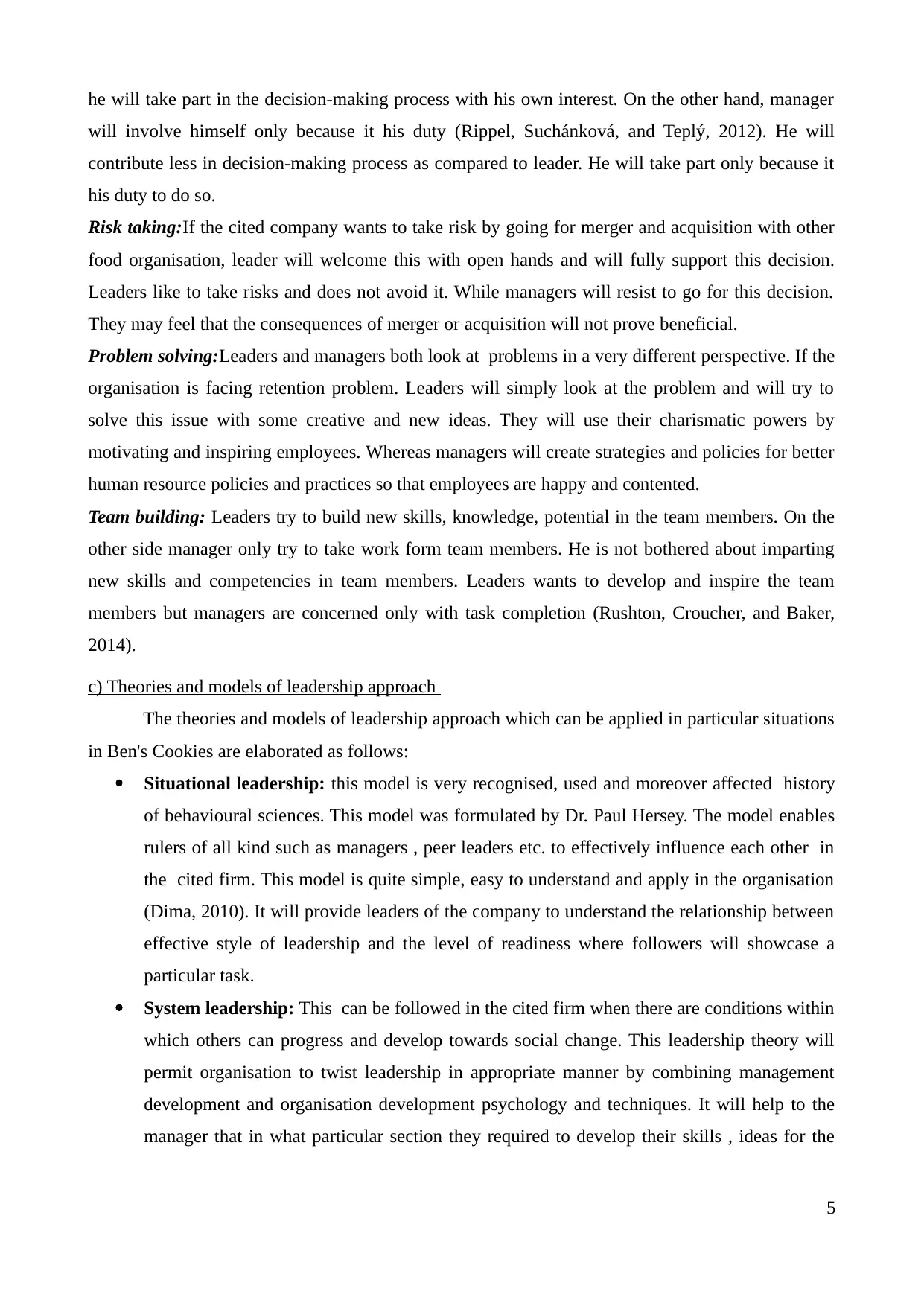
he will take part in the decision-making process with his own interest. On the other hand, manager
will involve himself only because it his duty (Rippel, Suchánková, and Teplý, 2012). He will
contribute less in decision-making process as compared to leader. He will take part only because it
his duty to do so.
Risk taking:If the cited company wants to take risk by going for merger and acquisition with other
food organisation, leader will welcome this with open hands and will fully support this decision.
Leaders like to take risks and does not avoid it. While managers will resist to go for this decision.
They may feel that the consequences of merger or acquisition will not prove beneficial.
Problem solving:Leaders and managers both look at problems in a very different perspective. If the
organisation is facing retention problem. Leaders will simply look at the problem and will try to
solve this issue with some creative and new ideas. They will use their charismatic powers by
motivating and inspiring employees. Whereas managers will create strategies and policies for better
human resource policies and practices so that employees are happy and contented.
Team building: Leaders try to build new skills, knowledge, potential in the team members. On the
other side manager only try to take work form team members. He is not bothered about imparting
new skills and competencies in team members. Leaders wants to develop and inspire the team
members but managers are concerned only with task completion (Rushton, Croucher, and Baker,
2014).
c) Theories and models of leadership approach
The theories and models of leadership approach which can be applied in particular situations
in Ben's Cookies are elaborated as follows:
Situational leadership: this model is very recognised, used and moreover affected history
of behavioural sciences. This model was formulated by Dr. Paul Hersey. The model enables
rulers of all kind such as managers , peer leaders etc. to effectively influence each other in
the cited firm. This model is quite simple, easy to understand and apply in the organisation
(Dima, 2010). It will provide leaders of the company to understand the relationship between
effective style of leadership and the level of readiness where followers will showcase a
particular task.
System leadership: This can be followed in the cited firm when there are conditions within
which others can progress and develop towards social change. This leadership theory will
permit organisation to twist leadership in appropriate manner by combining management
development and organisation development psychology and techniques. It will help to the
manager that in what particular section they required to develop their skills , ideas for the
5
will involve himself only because it his duty (Rippel, Suchánková, and Teplý, 2012). He will
contribute less in decision-making process as compared to leader. He will take part only because it
his duty to do so.
Risk taking:If the cited company wants to take risk by going for merger and acquisition with other
food organisation, leader will welcome this with open hands and will fully support this decision.
Leaders like to take risks and does not avoid it. While managers will resist to go for this decision.
They may feel that the consequences of merger or acquisition will not prove beneficial.
Problem solving:Leaders and managers both look at problems in a very different perspective. If the
organisation is facing retention problem. Leaders will simply look at the problem and will try to
solve this issue with some creative and new ideas. They will use their charismatic powers by
motivating and inspiring employees. Whereas managers will create strategies and policies for better
human resource policies and practices so that employees are happy and contented.
Team building: Leaders try to build new skills, knowledge, potential in the team members. On the
other side manager only try to take work form team members. He is not bothered about imparting
new skills and competencies in team members. Leaders wants to develop and inspire the team
members but managers are concerned only with task completion (Rushton, Croucher, and Baker,
2014).
c) Theories and models of leadership approach
The theories and models of leadership approach which can be applied in particular situations
in Ben's Cookies are elaborated as follows:
Situational leadership: this model is very recognised, used and moreover affected history
of behavioural sciences. This model was formulated by Dr. Paul Hersey. The model enables
rulers of all kind such as managers , peer leaders etc. to effectively influence each other in
the cited firm. This model is quite simple, easy to understand and apply in the organisation
(Dima, 2010). It will provide leaders of the company to understand the relationship between
effective style of leadership and the level of readiness where followers will showcase a
particular task.
System leadership: This can be followed in the cited firm when there are conditions within
which others can progress and develop towards social change. This leadership theory will
permit organisation to twist leadership in appropriate manner by combining management
development and organisation development psychology and techniques. It will help to the
manager that in what particular section they required to develop their skills , ideas for the
5
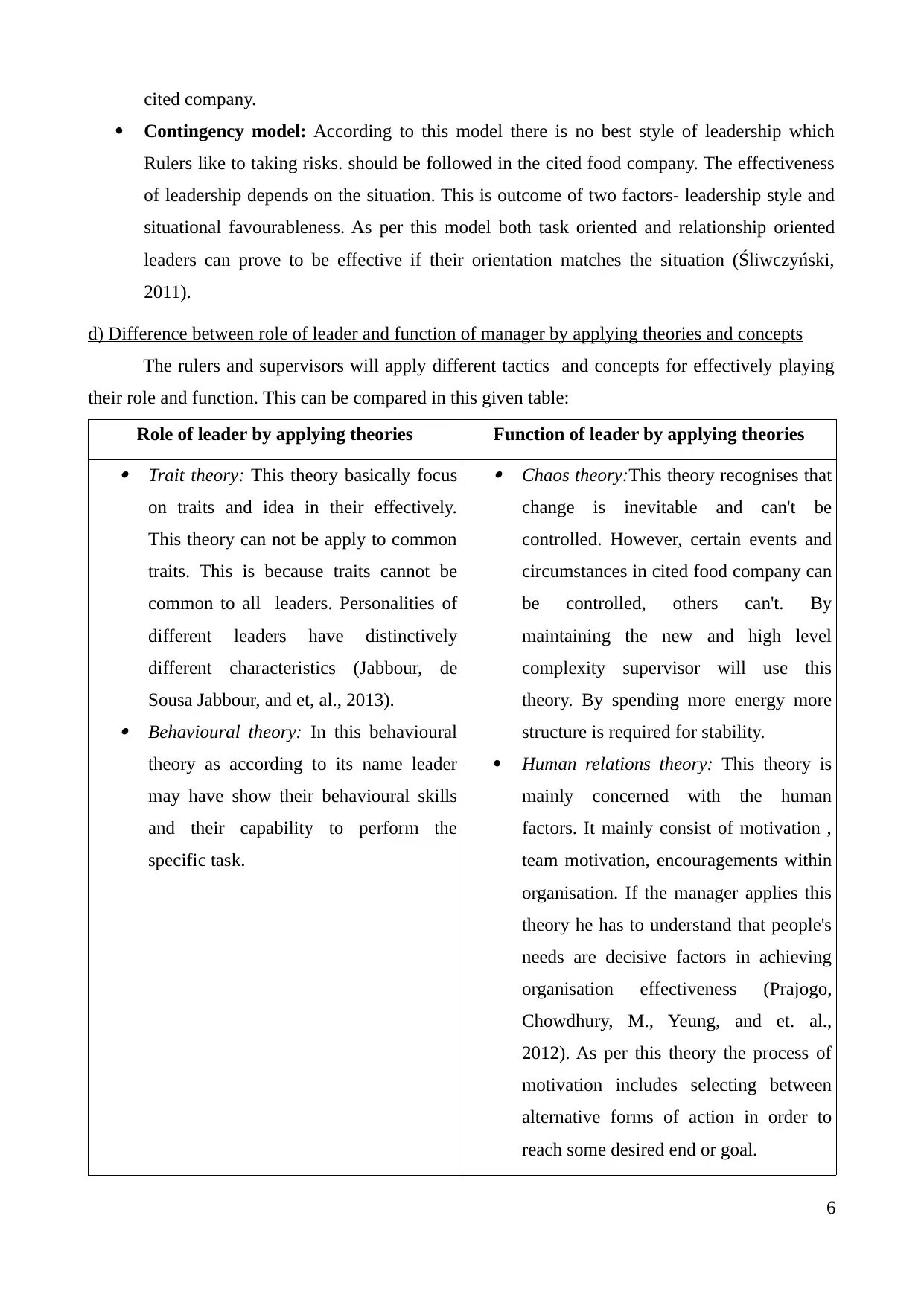
cited company.
Contingency model: According to this model there is no best style of leadership which
Rulers like to taking risks. should be followed in the cited food company. The effectiveness
of leadership depends on the situation. This is outcome of two factors- leadership style and
situational favourableness. As per this model both task oriented and relationship oriented
leaders can prove to be effective if their orientation matches the situation (Śliwczyński,
2011).
d) Difference between role of leader and function of manager by applying theories and concepts
The rulers and supervisors will apply different tactics and concepts for effectively playing
their role and function. This can be compared in this given table:
Role of leader by applying theories Function of leader by applying theories Trait theory: This theory basically focus
on traits and idea in their effectively.
This theory can not be apply to common
traits. This is because traits cannot be
common to all leaders. Personalities of
different leaders have distinctively
different characteristics (Jabbour, de
Sousa Jabbour, and et, al., 2013). Behavioural theory: In this behavioural
theory as according to its name leader
may have show their behavioural skills
and their capability to perform the
specific task.
Chaos theory:This theory recognises that
change is inevitable and can't be
controlled. However, certain events and
circumstances in cited food company can
be controlled, others can't. By
maintaining the new and high level
complexity supervisor will use this
theory. By spending more energy more
structure is required for stability.
Human relations theory: This theory is
mainly concerned with the human
factors. It mainly consist of motivation ,
team motivation, encouragements within
organisation. If the manager applies this
theory he has to understand that people's
needs are decisive factors in achieving
organisation effectiveness (Prajogo,
Chowdhury, M., Yeung, and et. al.,
2012). As per this theory the process of
motivation includes selecting between
alternative forms of action in order to
reach some desired end or goal.
6
Contingency model: According to this model there is no best style of leadership which
Rulers like to taking risks. should be followed in the cited food company. The effectiveness
of leadership depends on the situation. This is outcome of two factors- leadership style and
situational favourableness. As per this model both task oriented and relationship oriented
leaders can prove to be effective if their orientation matches the situation (Śliwczyński,
2011).
d) Difference between role of leader and function of manager by applying theories and concepts
The rulers and supervisors will apply different tactics and concepts for effectively playing
their role and function. This can be compared in this given table:
Role of leader by applying theories Function of leader by applying theories Trait theory: This theory basically focus
on traits and idea in their effectively.
This theory can not be apply to common
traits. This is because traits cannot be
common to all leaders. Personalities of
different leaders have distinctively
different characteristics (Jabbour, de
Sousa Jabbour, and et, al., 2013). Behavioural theory: In this behavioural
theory as according to its name leader
may have show their behavioural skills
and their capability to perform the
specific task.
Chaos theory:This theory recognises that
change is inevitable and can't be
controlled. However, certain events and
circumstances in cited food company can
be controlled, others can't. By
maintaining the new and high level
complexity supervisor will use this
theory. By spending more energy more
structure is required for stability.
Human relations theory: This theory is
mainly concerned with the human
factors. It mainly consist of motivation ,
team motivation, encouragements within
organisation. If the manager applies this
theory he has to understand that people's
needs are decisive factors in achieving
organisation effectiveness (Prajogo,
Chowdhury, M., Yeung, and et. al.,
2012). As per this theory the process of
motivation includes selecting between
alternative forms of action in order to
reach some desired end or goal.
6
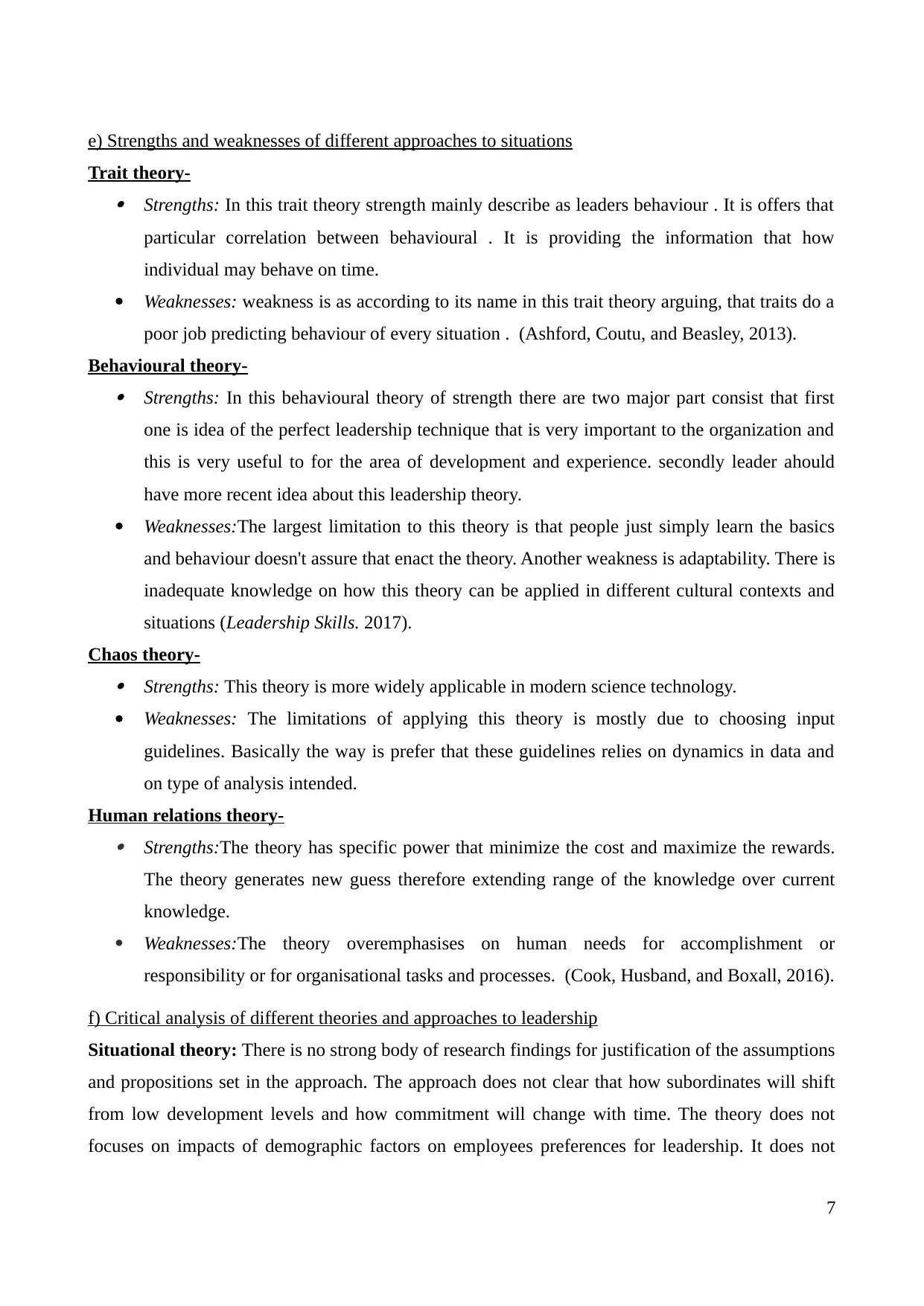
e) Strengths and weaknesses of different approaches to situations
Trait theory- Strengths: In this trait theory strength mainly describe as leaders behaviour . It is offers that
particular correlation between behavioural . It is providing the information that how
individual may behave on time.
Weaknesses: weakness is as according to its name in this trait theory arguing, that traits do a
poor job predicting behaviour of every situation . (Ashford, Coutu, and Beasley, 2013).
Behavioural theory- Strengths: In this behavioural theory of strength there are two major part consist that first
one is idea of the perfect leadership technique that is very important to the organization and
this is very useful to for the area of development and experience. secondly leader ahould
have more recent idea about this leadership theory.
Weaknesses:The largest limitation to this theory is that people just simply learn the basics
and behaviour doesn't assure that enact the theory. Another weakness is adaptability. There is
inadequate knowledge on how this theory can be applied in different cultural contexts and
situations (Leadership Skills. 2017).
Chaos theory- Strengths: This theory is more widely applicable in modern science technology.
Weaknesses: The limitations of applying this theory is mostly due to choosing input
guidelines. Basically the way is prefer that these guidelines relies on dynamics in data and
on type of analysis intended.
Human relations theory- Strengths:The theory has specific power that minimize the cost and maximize the rewards.
The theory generates new guess therefore extending range of the knowledge over current
knowledge.
Weaknesses:The theory overemphasises on human needs for accomplishment or
responsibility or for organisational tasks and processes. (Cook, Husband, and Boxall, 2016).
f) Critical analysis of different theories and approaches to leadership
Situational theory: There is no strong body of research findings for justification of the assumptions
and propositions set in the approach. The approach does not clear that how subordinates will shift
from low development levels and how commitment will change with time. The theory does not
focuses on impacts of demographic factors on employees preferences for leadership. It does not
7
Trait theory- Strengths: In this trait theory strength mainly describe as leaders behaviour . It is offers that
particular correlation between behavioural . It is providing the information that how
individual may behave on time.
Weaknesses: weakness is as according to its name in this trait theory arguing, that traits do a
poor job predicting behaviour of every situation . (Ashford, Coutu, and Beasley, 2013).
Behavioural theory- Strengths: In this behavioural theory of strength there are two major part consist that first
one is idea of the perfect leadership technique that is very important to the organization and
this is very useful to for the area of development and experience. secondly leader ahould
have more recent idea about this leadership theory.
Weaknesses:The largest limitation to this theory is that people just simply learn the basics
and behaviour doesn't assure that enact the theory. Another weakness is adaptability. There is
inadequate knowledge on how this theory can be applied in different cultural contexts and
situations (Leadership Skills. 2017).
Chaos theory- Strengths: This theory is more widely applicable in modern science technology.
Weaknesses: The limitations of applying this theory is mostly due to choosing input
guidelines. Basically the way is prefer that these guidelines relies on dynamics in data and
on type of analysis intended.
Human relations theory- Strengths:The theory has specific power that minimize the cost and maximize the rewards.
The theory generates new guess therefore extending range of the knowledge over current
knowledge.
Weaknesses:The theory overemphasises on human needs for accomplishment or
responsibility or for organisational tasks and processes. (Cook, Husband, and Boxall, 2016).
f) Critical analysis of different theories and approaches to leadership
Situational theory: There is no strong body of research findings for justification of the assumptions
and propositions set in the approach. The approach does not clear that how subordinates will shift
from low development levels and how commitment will change with time. The theory does not
focuses on impacts of demographic factors on employees preferences for leadership. It does not
7
Paraphrase This Document
Need a fresh take? Get an instant paraphrase of this document with our AI Paraphraser
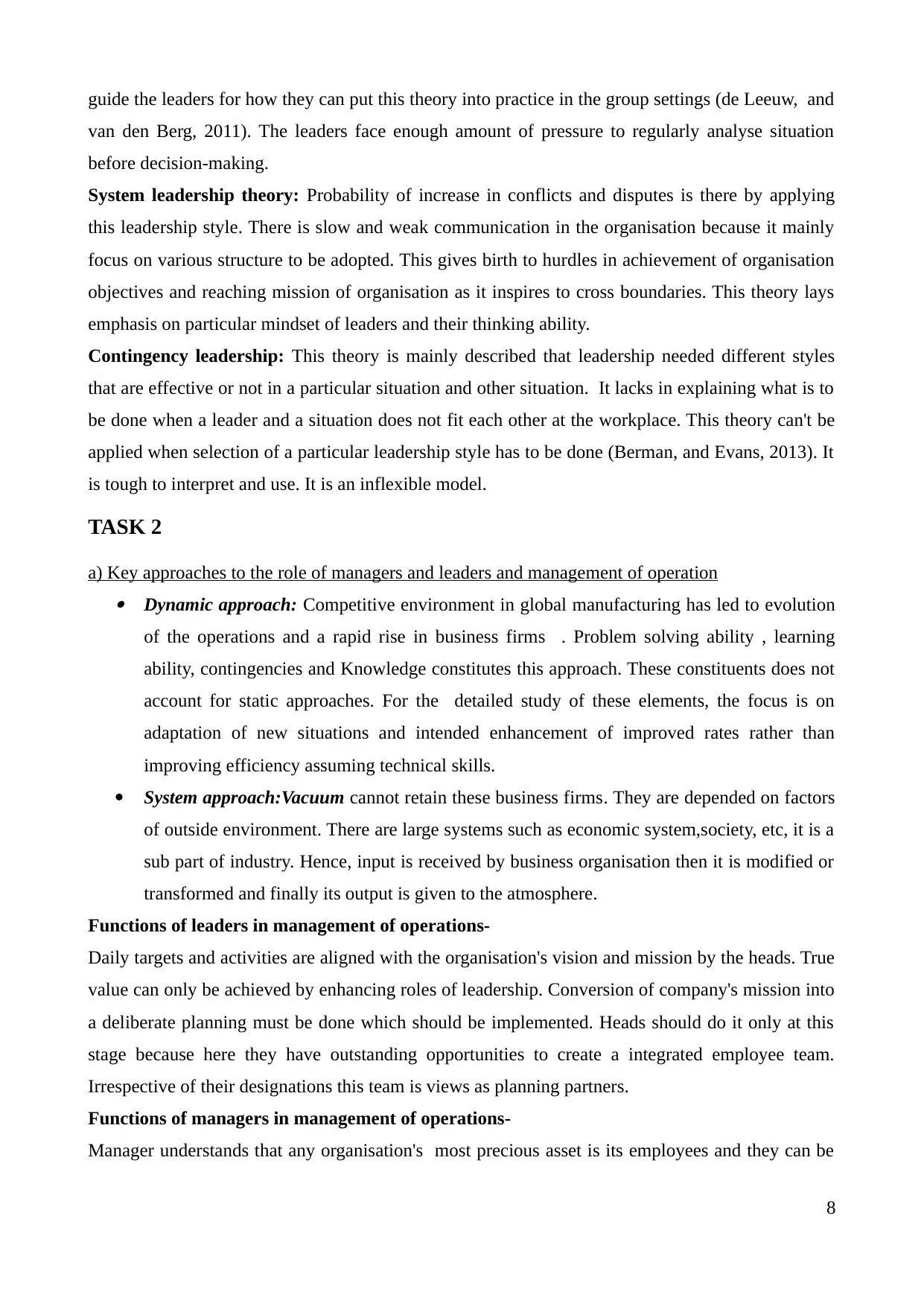
guide the leaders for how they can put this theory into practice in the group settings (de Leeuw, and
van den Berg, 2011). The leaders face enough amount of pressure to regularly analyse situation
before decision-making.
System leadership theory: Probability of increase in conflicts and disputes is there by applying
this leadership style. There is slow and weak communication in the organisation because it mainly
focus on various structure to be adopted. This gives birth to hurdles in achievement of organisation
objectives and reaching mission of organisation as it inspires to cross boundaries. This theory lays
emphasis on particular mindset of leaders and their thinking ability.
Contingency leadership: This theory is mainly described that leadership needed different styles
that are effective or not in a particular situation and other situation. It lacks in explaining what is to
be done when a leader and a situation does not fit each other at the workplace. This theory can't be
applied when selection of a particular leadership style has to be done (Berman, and Evans, 2013). It
is tough to interpret and use. It is an inflexible model.
TASK 2
a) Key approaches to the role of managers and leaders and management of operation Dynamic approach: Competitive environment in global manufacturing has led to evolution
of the operations and a rapid rise in business firms . Problem solving ability , learning
ability, contingencies and Knowledge constitutes this approach. These constituents does not
account for static approaches. For the detailed study of these elements, the focus is on
adaptation of new situations and intended enhancement of improved rates rather than
improving efficiency assuming technical skills.
System approach:Vacuum cannot retain these business firms. They are depended on factors
of outside environment. There are large systems such as economic system,society, etc, it is a
sub part of industry. Hence, input is received by business organisation then it is modified or
transformed and finally its output is given to the atmosphere.
Functions of leaders in management of operations-
Daily targets and activities are aligned with the organisation's vision and mission by the heads. True
value can only be achieved by enhancing roles of leadership. Conversion of company's mission into
a deliberate planning must be done which should be implemented. Heads should do it only at this
stage because here they have outstanding opportunities to create a integrated employee team.
Irrespective of their designations this team is views as planning partners.
Functions of managers in management of operations-
Manager understands that any organisation's most precious asset is its employees and they can be
8
van den Berg, 2011). The leaders face enough amount of pressure to regularly analyse situation
before decision-making.
System leadership theory: Probability of increase in conflicts and disputes is there by applying
this leadership style. There is slow and weak communication in the organisation because it mainly
focus on various structure to be adopted. This gives birth to hurdles in achievement of organisation
objectives and reaching mission of organisation as it inspires to cross boundaries. This theory lays
emphasis on particular mindset of leaders and their thinking ability.
Contingency leadership: This theory is mainly described that leadership needed different styles
that are effective or not in a particular situation and other situation. It lacks in explaining what is to
be done when a leader and a situation does not fit each other at the workplace. This theory can't be
applied when selection of a particular leadership style has to be done (Berman, and Evans, 2013). It
is tough to interpret and use. It is an inflexible model.
TASK 2
a) Key approaches to the role of managers and leaders and management of operation Dynamic approach: Competitive environment in global manufacturing has led to evolution
of the operations and a rapid rise in business firms . Problem solving ability , learning
ability, contingencies and Knowledge constitutes this approach. These constituents does not
account for static approaches. For the detailed study of these elements, the focus is on
adaptation of new situations and intended enhancement of improved rates rather than
improving efficiency assuming technical skills.
System approach:Vacuum cannot retain these business firms. They are depended on factors
of outside environment. There are large systems such as economic system,society, etc, it is a
sub part of industry. Hence, input is received by business organisation then it is modified or
transformed and finally its output is given to the atmosphere.
Functions of leaders in management of operations-
Daily targets and activities are aligned with the organisation's vision and mission by the heads. True
value can only be achieved by enhancing roles of leadership. Conversion of company's mission into
a deliberate planning must be done which should be implemented. Heads should do it only at this
stage because here they have outstanding opportunities to create a integrated employee team.
Irrespective of their designations this team is views as planning partners.
Functions of managers in management of operations-
Manager understands that any organisation's most precious asset is its employees and they can be
8
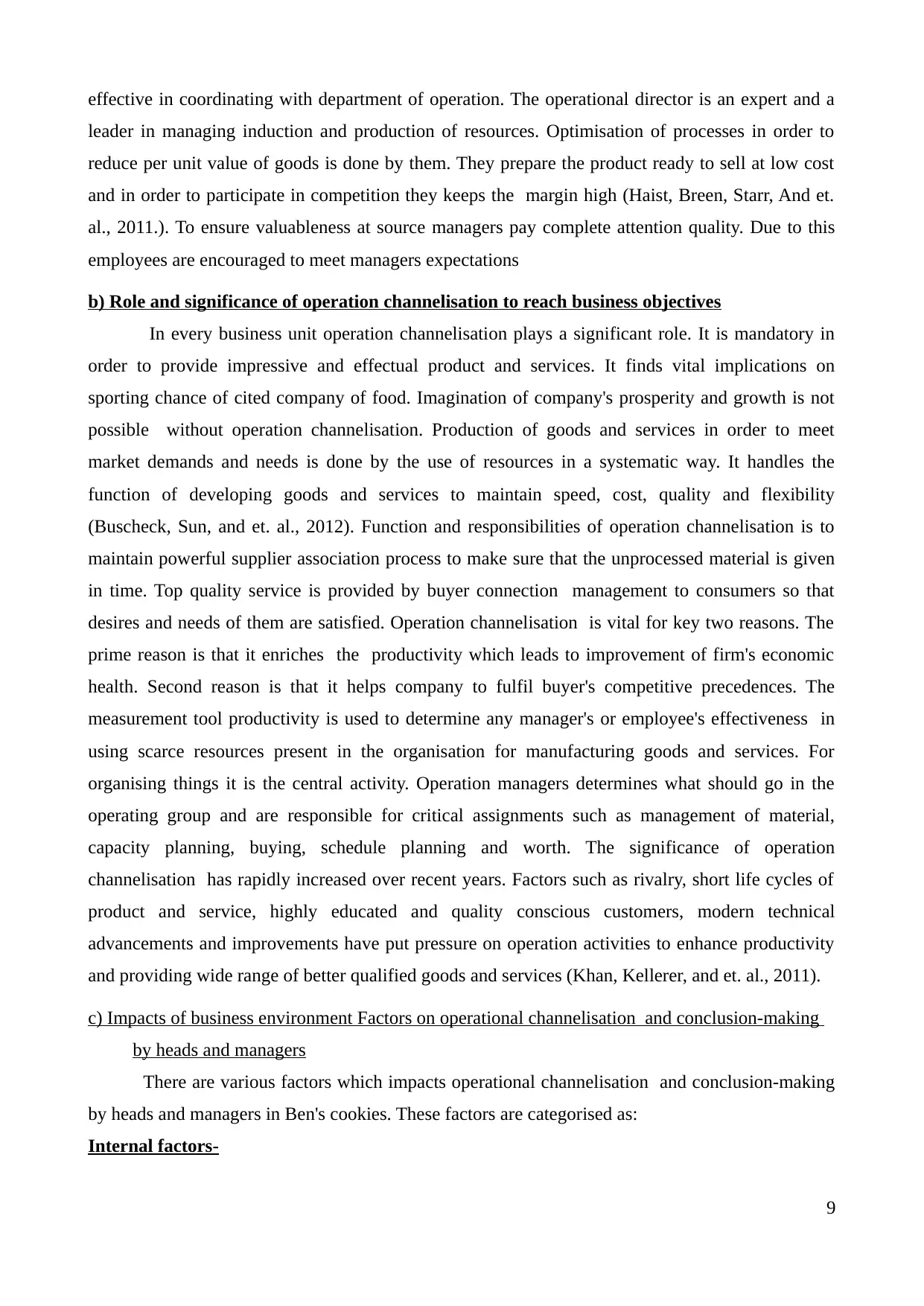
effective in coordinating with department of operation. The operational director is an expert and a
leader in managing induction and production of resources. Optimisation of processes in order to
reduce per unit value of goods is done by them. They prepare the product ready to sell at low cost
and in order to participate in competition they keeps the margin high (Haist, Breen, Starr, And et.
al., 2011.). To ensure valuableness at source managers pay complete attention quality. Due to this
employees are encouraged to meet managers expectations
b) Role and significance of operation channelisation to reach business objectives
In every business unit operation channelisation plays a significant role. It is mandatory in
order to provide impressive and effectual product and services. It finds vital implications on
sporting chance of cited company of food. Imagination of company's prosperity and growth is not
possible without operation channelisation. Production of goods and services in order to meet
market demands and needs is done by the use of resources in a systematic way. It handles the
function of developing goods and services to maintain speed, cost, quality and flexibility
(Buscheck, Sun, and et. al., 2012). Function and responsibilities of operation channelisation is to
maintain powerful supplier association process to make sure that the unprocessed material is given
in time. Top quality service is provided by buyer connection management to consumers so that
desires and needs of them are satisfied. Operation channelisation is vital for key two reasons. The
prime reason is that it enriches the productivity which leads to improvement of firm's economic
health. Second reason is that it helps company to fulfil buyer's competitive precedences. The
measurement tool productivity is used to determine any manager's or employee's effectiveness in
using scarce resources present in the organisation for manufacturing goods and services. For
organising things it is the central activity. Operation managers determines what should go in the
operating group and are responsible for critical assignments such as management of material,
capacity planning, buying, schedule planning and worth. The significance of operation
channelisation has rapidly increased over recent years. Factors such as rivalry, short life cycles of
product and service, highly educated and quality conscious customers, modern technical
advancements and improvements have put pressure on operation activities to enhance productivity
and providing wide range of better qualified goods and services (Khan, Kellerer, and et. al., 2011).
c) Impacts of business environment Factors on operational channelisation and conclusion-making
by heads and managers
There are various factors which impacts operational channelisation and conclusion-making
by heads and managers in Ben's cookies. These factors are categorised as:
Internal factors-
9
leader in managing induction and production of resources. Optimisation of processes in order to
reduce per unit value of goods is done by them. They prepare the product ready to sell at low cost
and in order to participate in competition they keeps the margin high (Haist, Breen, Starr, And et.
al., 2011.). To ensure valuableness at source managers pay complete attention quality. Due to this
employees are encouraged to meet managers expectations
b) Role and significance of operation channelisation to reach business objectives
In every business unit operation channelisation plays a significant role. It is mandatory in
order to provide impressive and effectual product and services. It finds vital implications on
sporting chance of cited company of food. Imagination of company's prosperity and growth is not
possible without operation channelisation. Production of goods and services in order to meet
market demands and needs is done by the use of resources in a systematic way. It handles the
function of developing goods and services to maintain speed, cost, quality and flexibility
(Buscheck, Sun, and et. al., 2012). Function and responsibilities of operation channelisation is to
maintain powerful supplier association process to make sure that the unprocessed material is given
in time. Top quality service is provided by buyer connection management to consumers so that
desires and needs of them are satisfied. Operation channelisation is vital for key two reasons. The
prime reason is that it enriches the productivity which leads to improvement of firm's economic
health. Second reason is that it helps company to fulfil buyer's competitive precedences. The
measurement tool productivity is used to determine any manager's or employee's effectiveness in
using scarce resources present in the organisation for manufacturing goods and services. For
organising things it is the central activity. Operation managers determines what should go in the
operating group and are responsible for critical assignments such as management of material,
capacity planning, buying, schedule planning and worth. The significance of operation
channelisation has rapidly increased over recent years. Factors such as rivalry, short life cycles of
product and service, highly educated and quality conscious customers, modern technical
advancements and improvements have put pressure on operation activities to enhance productivity
and providing wide range of better qualified goods and services (Khan, Kellerer, and et. al., 2011).
c) Impacts of business environment Factors on operational channelisation and conclusion-making
by heads and managers
There are various factors which impacts operational channelisation and conclusion-making
by heads and managers in Ben's cookies. These factors are categorised as:
Internal factors-
9

Value system:Functions of operational channelisation are as per the meme, preciousness and
terms&conditions of cited firm. Every member should follow the regulatory framework of
organisation. Each department should abide by the organisation's laws, guidelines and
regulations. Fiscal variables: Financial factors such as fiscal contracts, routine, fiscal position and
capital framework of the organisation makes huge impacts on the operational channelisation
and its functions.
Internal connections: Employees coordination, employer and employees
relation,hierarchical relations between all the managers, connection between the internal
stakeholders affects diplomatic operations of cited food company.
External factors- Suppliers: Suppliers are the people responsible for supplies and needs input to the sector of
operation . An important role is played by them in operational channelisation. Complete
production process will hinder if the input supply is restricted. For ensuring smooth flow of
production supplier play a very important role (Koontz, 2010).
Competitors: Rival companies also makes a huge impact on operational management of the
cited firm. To survive and sustain in the tough competition company has to closely monitor
and analyse market conditions and fluctuations. According to it policies and strategies
should be formed so that it does not lack behind in the competitive business world.
Marketing intermediaries: They are the middle parties who helps company in
promotions,products and services hawking and distribution to ultimate goods and services
customers. They act as an significant bridge between organisation and customers.
d) How can heads and managers enhance the effectiveness of management of operation
To improve efficiencies of operational management in Ben's cookies responsibility is taken
by heads and managers . Through this, different ways to reward employees are applied by the heads
and managers to achieve business targets and objectives. It consists of promotions, bonus which is
offered by manager to boost up employees motivation level. Further, it aids employees so that they
contribute sincere efforts in their jobs and attaining shared goals. For effective time management
leaders use time management methods and tools. Deadlines are setup by them, time tables are
formed and work is prioritised (Dhoul, 2014). This gives positive effects for the company as the
customers gets satisfied by the offered services. Manager gets support by this to reach business
objective and maintaining complete productivity of the firm also. Also leaders communicate
effectively with their employees which reduces number of conflicts, confusions, misunderstandings,
10
terms&conditions of cited firm. Every member should follow the regulatory framework of
organisation. Each department should abide by the organisation's laws, guidelines and
regulations. Fiscal variables: Financial factors such as fiscal contracts, routine, fiscal position and
capital framework of the organisation makes huge impacts on the operational channelisation
and its functions.
Internal connections: Employees coordination, employer and employees
relation,hierarchical relations between all the managers, connection between the internal
stakeholders affects diplomatic operations of cited food company.
External factors- Suppliers: Suppliers are the people responsible for supplies and needs input to the sector of
operation . An important role is played by them in operational channelisation. Complete
production process will hinder if the input supply is restricted. For ensuring smooth flow of
production supplier play a very important role (Koontz, 2010).
Competitors: Rival companies also makes a huge impact on operational management of the
cited firm. To survive and sustain in the tough competition company has to closely monitor
and analyse market conditions and fluctuations. According to it policies and strategies
should be formed so that it does not lack behind in the competitive business world.
Marketing intermediaries: They are the middle parties who helps company in
promotions,products and services hawking and distribution to ultimate goods and services
customers. They act as an significant bridge between organisation and customers.
d) How can heads and managers enhance the effectiveness of management of operation
To improve efficiencies of operational management in Ben's cookies responsibility is taken
by heads and managers . Through this, different ways to reward employees are applied by the heads
and managers to achieve business targets and objectives. It consists of promotions, bonus which is
offered by manager to boost up employees motivation level. Further, it aids employees so that they
contribute sincere efforts in their jobs and attaining shared goals. For effective time management
leaders use time management methods and tools. Deadlines are setup by them, time tables are
formed and work is prioritised (Dhoul, 2014). This gives positive effects for the company as the
customers gets satisfied by the offered services. Manager gets support by this to reach business
objective and maintaining complete productivity of the firm also. Also leaders communicate
effectively with their employees which reduces number of conflicts, confusions, misunderstandings,
10
Secure Best Marks with AI Grader
Need help grading? Try our AI Grader for instant feedback on your assignments.
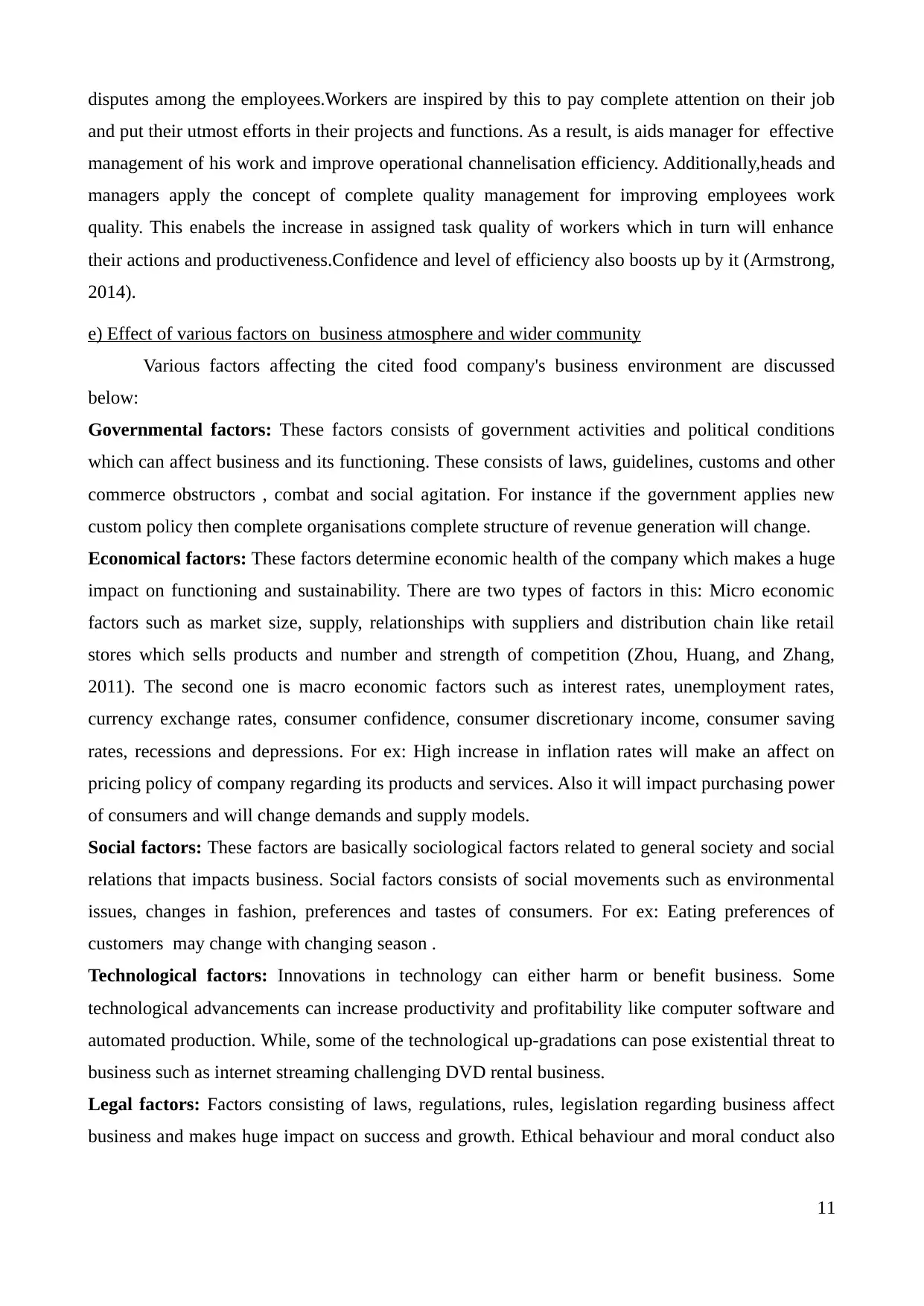
disputes among the employees.Workers are inspired by this to pay complete attention on their job
and put their utmost efforts in their projects and functions. As a result, is aids manager for effective
management of his work and improve operational channelisation efficiency. Additionally,heads and
managers apply the concept of complete quality management for improving employees work
quality. This enabels the increase in assigned task quality of workers which in turn will enhance
their actions and productiveness.Confidence and level of efficiency also boosts up by it (Armstrong,
2014).
e) Effect of various factors on business atmosphere and wider community
Various factors affecting the cited food company's business environment are discussed
below:
Governmental factors: These factors consists of government activities and political conditions
which can affect business and its functioning. These consists of laws, guidelines, customs and other
commerce obstructors , combat and social agitation. For instance if the government applies new
custom policy then complete organisations complete structure of revenue generation will change.
Economical factors: These factors determine economic health of the company which makes a huge
impact on functioning and sustainability. There are two types of factors in this: Micro economic
factors such as market size, supply, relationships with suppliers and distribution chain like retail
stores which sells products and number and strength of competition (Zhou, Huang, and Zhang,
2011). The second one is macro economic factors such as interest rates, unemployment rates,
currency exchange rates, consumer confidence, consumer discretionary income, consumer saving
rates, recessions and depressions. For ex: High increase in inflation rates will make an affect on
pricing policy of company regarding its products and services. Also it will impact purchasing power
of consumers and will change demands and supply models.
Social factors: These factors are basically sociological factors related to general society and social
relations that impacts business. Social factors consists of social movements such as environmental
issues, changes in fashion, preferences and tastes of consumers. For ex: Eating preferences of
customers may change with changing season .
Technological factors: Innovations in technology can either harm or benefit business. Some
technological advancements can increase productivity and profitability like computer software and
automated production. While, some of the technological up-gradations can pose existential threat to
business such as internet streaming challenging DVD rental business.
Legal factors: Factors consisting of laws, regulations, rules, legislation regarding business affect
business and makes huge impact on success and growth. Ethical behaviour and moral conduct also
11
and put their utmost efforts in their projects and functions. As a result, is aids manager for effective
management of his work and improve operational channelisation efficiency. Additionally,heads and
managers apply the concept of complete quality management for improving employees work
quality. This enabels the increase in assigned task quality of workers which in turn will enhance
their actions and productiveness.Confidence and level of efficiency also boosts up by it (Armstrong,
2014).
e) Effect of various factors on business atmosphere and wider community
Various factors affecting the cited food company's business environment are discussed
below:
Governmental factors: These factors consists of government activities and political conditions
which can affect business and its functioning. These consists of laws, guidelines, customs and other
commerce obstructors , combat and social agitation. For instance if the government applies new
custom policy then complete organisations complete structure of revenue generation will change.
Economical factors: These factors determine economic health of the company which makes a huge
impact on functioning and sustainability. There are two types of factors in this: Micro economic
factors such as market size, supply, relationships with suppliers and distribution chain like retail
stores which sells products and number and strength of competition (Zhou, Huang, and Zhang,
2011). The second one is macro economic factors such as interest rates, unemployment rates,
currency exchange rates, consumer confidence, consumer discretionary income, consumer saving
rates, recessions and depressions. For ex: High increase in inflation rates will make an affect on
pricing policy of company regarding its products and services. Also it will impact purchasing power
of consumers and will change demands and supply models.
Social factors: These factors are basically sociological factors related to general society and social
relations that impacts business. Social factors consists of social movements such as environmental
issues, changes in fashion, preferences and tastes of consumers. For ex: Eating preferences of
customers may change with changing season .
Technological factors: Innovations in technology can either harm or benefit business. Some
technological advancements can increase productivity and profitability like computer software and
automated production. While, some of the technological up-gradations can pose existential threat to
business such as internet streaming challenging DVD rental business.
Legal factors: Factors consisting of laws, regulations, rules, legislation regarding business affect
business and makes huge impact on success and growth. Ethical behaviour and moral conduct also
11
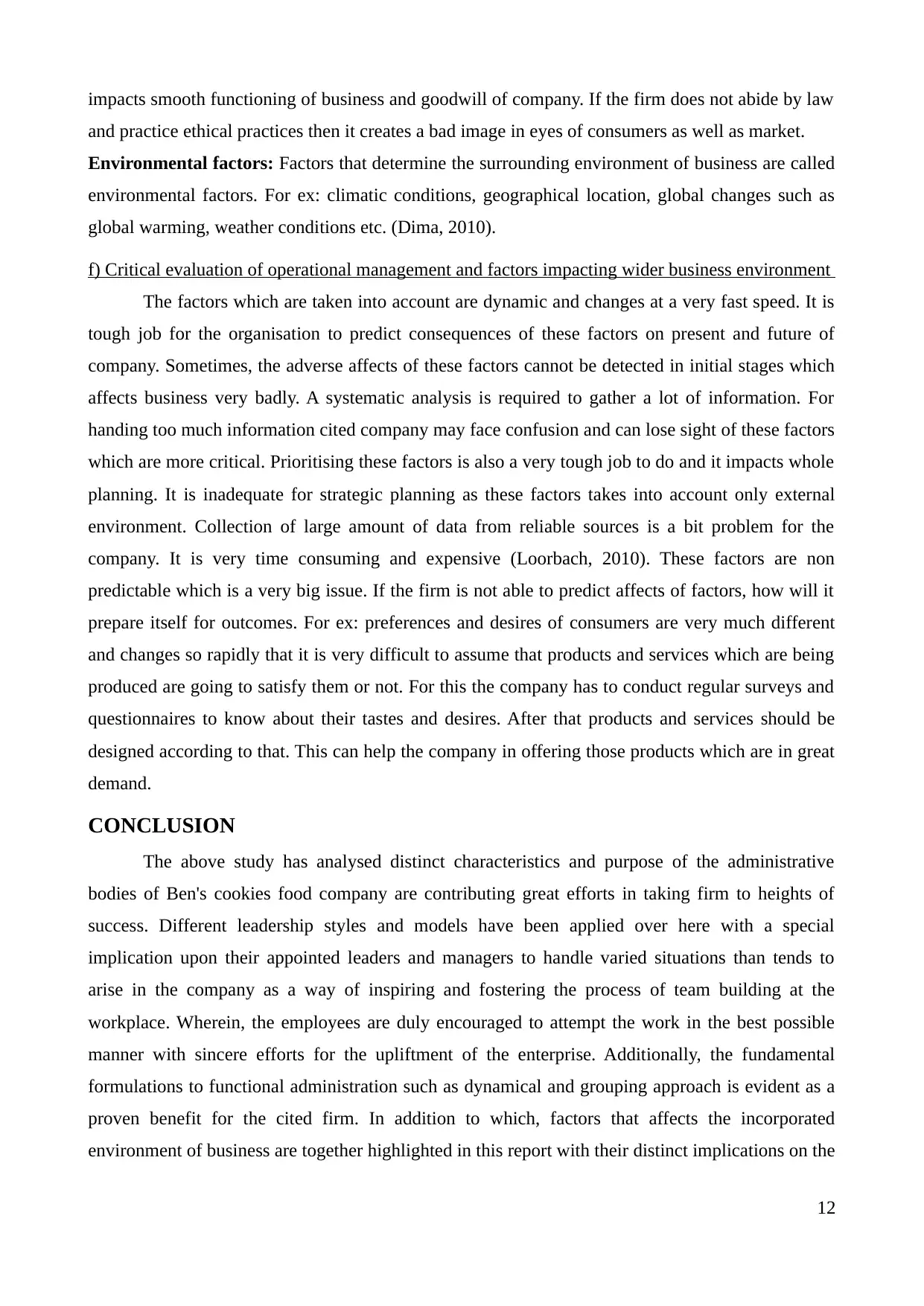
impacts smooth functioning of business and goodwill of company. If the firm does not abide by law
and practice ethical practices then it creates a bad image in eyes of consumers as well as market.
Environmental factors: Factors that determine the surrounding environment of business are called
environmental factors. For ex: climatic conditions, geographical location, global changes such as
global warming, weather conditions etc. (Dima, 2010).
f) Critical evaluation of operational management and factors impacting wider business environment
The factors which are taken into account are dynamic and changes at a very fast speed. It is
tough job for the organisation to predict consequences of these factors on present and future of
company. Sometimes, the adverse affects of these factors cannot be detected in initial stages which
affects business very badly. A systematic analysis is required to gather a lot of information. For
handing too much information cited company may face confusion and can lose sight of these factors
which are more critical. Prioritising these factors is also a very tough job to do and it impacts whole
planning. It is inadequate for strategic planning as these factors takes into account only external
environment. Collection of large amount of data from reliable sources is a bit problem for the
company. It is very time consuming and expensive (Loorbach, 2010). These factors are non
predictable which is a very big issue. If the firm is not able to predict affects of factors, how will it
prepare itself for outcomes. For ex: preferences and desires of consumers are very much different
and changes so rapidly that it is very difficult to assume that products and services which are being
produced are going to satisfy them or not. For this the company has to conduct regular surveys and
questionnaires to know about their tastes and desires. After that products and services should be
designed according to that. This can help the company in offering those products which are in great
demand.
CONCLUSION
The above study has analysed distinct characteristics and purpose of the administrative
bodies of Ben's cookies food company are contributing great efforts in taking firm to heights of
success. Different leadership styles and models have been applied over here with a special
implication upon their appointed leaders and managers to handle varied situations than tends to
arise in the company as a way of inspiring and fostering the process of team building at the
workplace. Wherein, the employees are duly encouraged to attempt the work in the best possible
manner with sincere efforts for the upliftment of the enterprise. Additionally, the fundamental
formulations to functional administration such as dynamical and grouping approach is evident as a
proven benefit for the cited firm. In addition to which, factors that affects the incorporated
environment of business are together highlighted in this report with their distinct implications on the
12
and practice ethical practices then it creates a bad image in eyes of consumers as well as market.
Environmental factors: Factors that determine the surrounding environment of business are called
environmental factors. For ex: climatic conditions, geographical location, global changes such as
global warming, weather conditions etc. (Dima, 2010).
f) Critical evaluation of operational management and factors impacting wider business environment
The factors which are taken into account are dynamic and changes at a very fast speed. It is
tough job for the organisation to predict consequences of these factors on present and future of
company. Sometimes, the adverse affects of these factors cannot be detected in initial stages which
affects business very badly. A systematic analysis is required to gather a lot of information. For
handing too much information cited company may face confusion and can lose sight of these factors
which are more critical. Prioritising these factors is also a very tough job to do and it impacts whole
planning. It is inadequate for strategic planning as these factors takes into account only external
environment. Collection of large amount of data from reliable sources is a bit problem for the
company. It is very time consuming and expensive (Loorbach, 2010). These factors are non
predictable which is a very big issue. If the firm is not able to predict affects of factors, how will it
prepare itself for outcomes. For ex: preferences and desires of consumers are very much different
and changes so rapidly that it is very difficult to assume that products and services which are being
produced are going to satisfy them or not. For this the company has to conduct regular surveys and
questionnaires to know about their tastes and desires. After that products and services should be
designed according to that. This can help the company in offering those products which are in great
demand.
CONCLUSION
The above study has analysed distinct characteristics and purpose of the administrative
bodies of Ben's cookies food company are contributing great efforts in taking firm to heights of
success. Different leadership styles and models have been applied over here with a special
implication upon their appointed leaders and managers to handle varied situations than tends to
arise in the company as a way of inspiring and fostering the process of team building at the
workplace. Wherein, the employees are duly encouraged to attempt the work in the best possible
manner with sincere efforts for the upliftment of the enterprise. Additionally, the fundamental
formulations to functional administration such as dynamical and grouping approach is evident as a
proven benefit for the cited firm. In addition to which, factors that affects the incorporated
environment of business are together highlighted in this report with their distinct implications on the
12
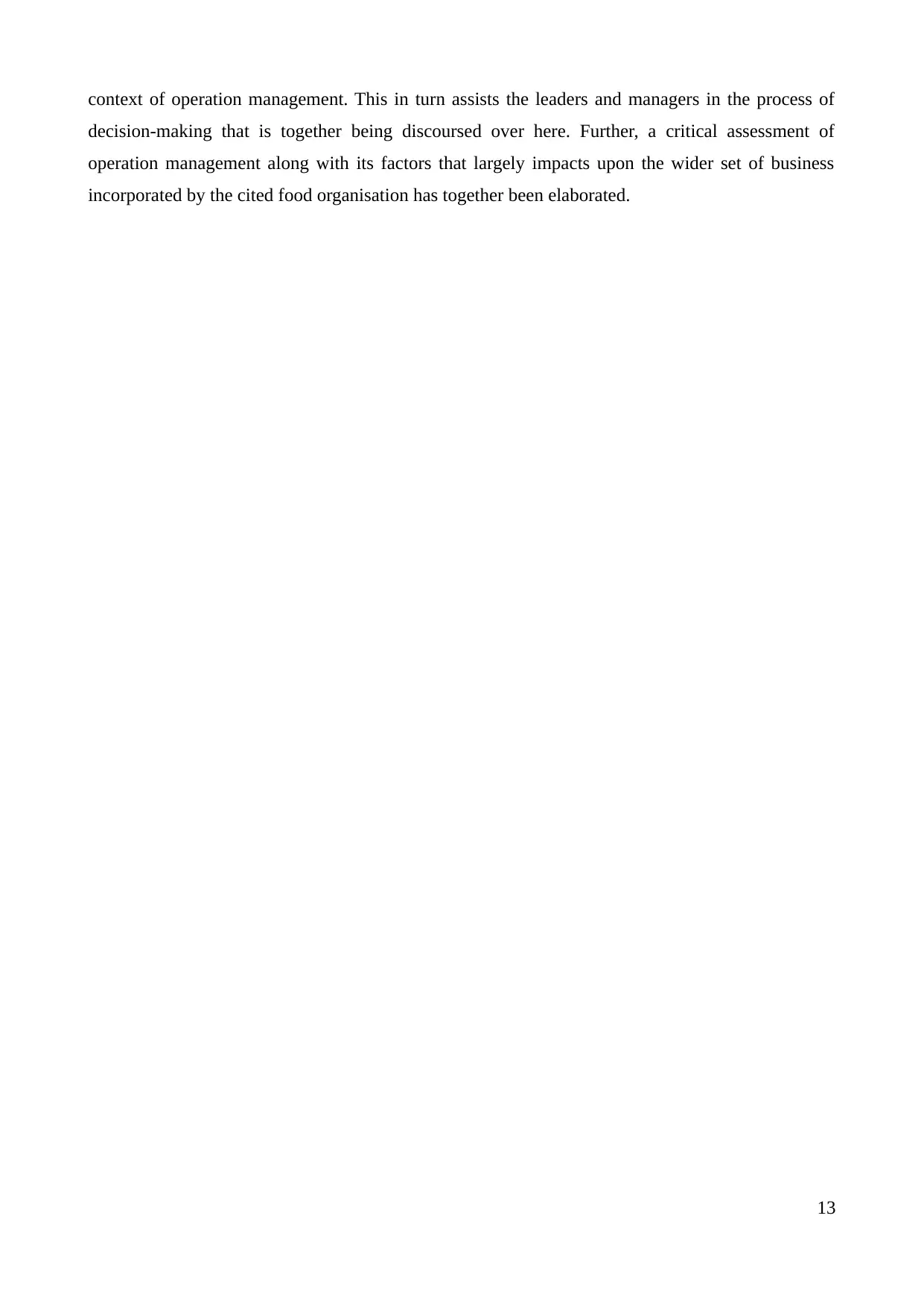
context of operation management. This in turn assists the leaders and managers in the process of
decision-making that is together being discoursed over here. Further, a critical assessment of
operation management along with its factors that largely impacts upon the wider set of business
incorporated by the cited food organisation has together been elaborated.
13
decision-making that is together being discoursed over here. Further, a critical assessment of
operation management along with its factors that largely impacts upon the wider set of business
incorporated by the cited food organisation has together been elaborated.
13
Paraphrase This Document
Need a fresh take? Get an instant paraphrase of this document with our AI Paraphraser
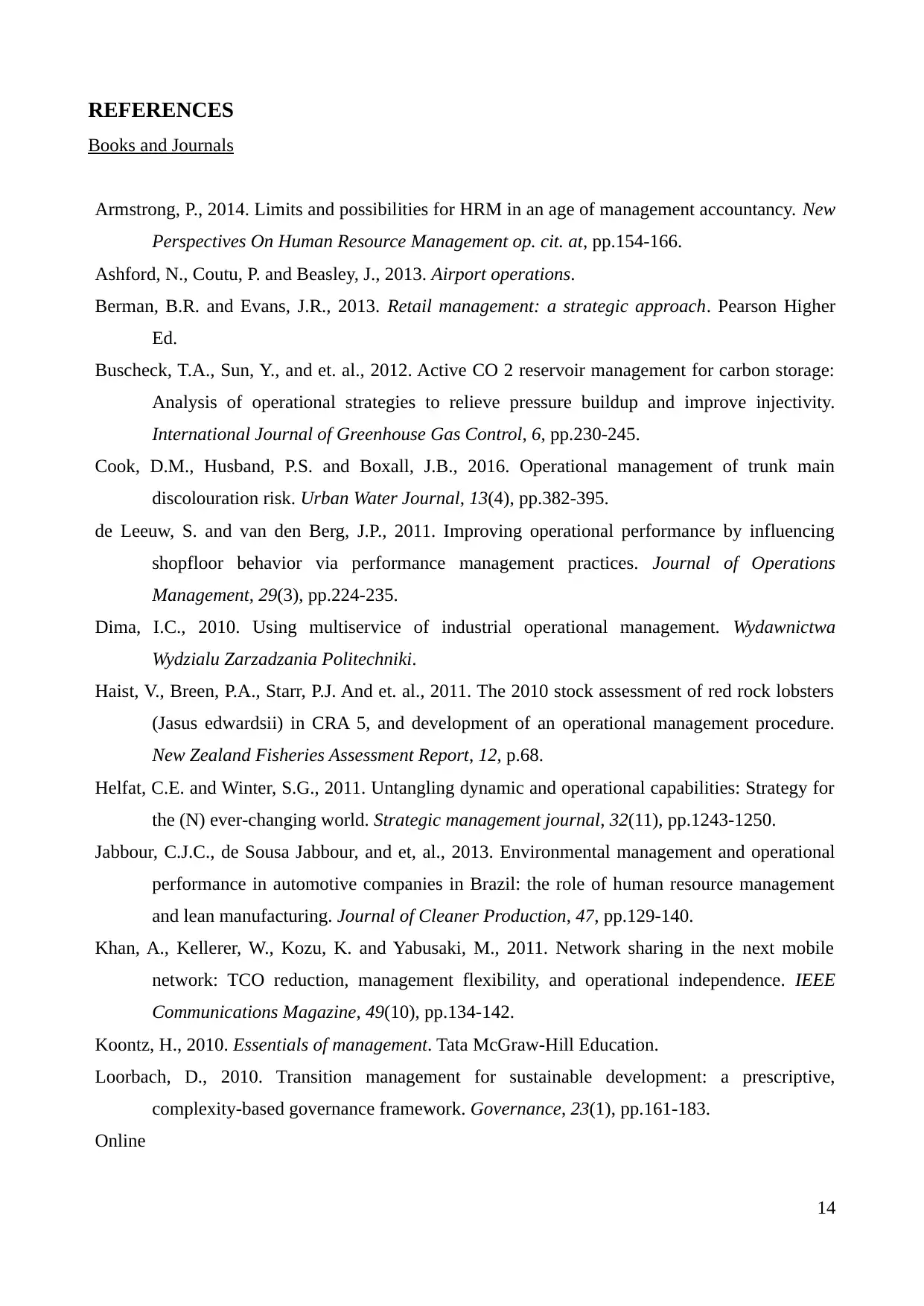
REFERENCES
Books and Journals
Armstrong, P., 2014. Limits and possibilities for HRM in an age of management accountancy. New
Perspectives On Human Resource Management op. cit. at, pp.154-166.
Ashford, N., Coutu, P. and Beasley, J., 2013. Airport operations.
Berman, B.R. and Evans, J.R., 2013. Retail management: a strategic approach. Pearson Higher
Ed.
Buscheck, T.A., Sun, Y., and et. al., 2012. Active CO 2 reservoir management for carbon storage:
Analysis of operational strategies to relieve pressure buildup and improve injectivity.
International Journal of Greenhouse Gas Control, 6, pp.230-245.
Cook, D.M., Husband, P.S. and Boxall, J.B., 2016. Operational management of trunk main
discolouration risk. Urban Water Journal, 13(4), pp.382-395.
de Leeuw, S. and van den Berg, J.P., 2011. Improving operational performance by influencing
shopfloor behavior via performance management practices. Journal of Operations
Management, 29(3), pp.224-235.
Dima, I.C., 2010. Using multiservice of industrial operational management. Wydawnictwa
Wydzialu Zarzadzania Politechniki.
Haist, V., Breen, P.A., Starr, P.J. And et. al., 2011. The 2010 stock assessment of red rock lobsters
(Jasus edwardsii) in CRA 5, and development of an operational management procedure.
New Zealand Fisheries Assessment Report, 12, p.68.
Helfat, C.E. and Winter, S.G., 2011. Untangling dynamic and operational capabilities: Strategy for
the (N) ever‐changing world. Strategic management journal, 32(11), pp.1243-1250.
Jabbour, C.J.C., de Sousa Jabbour, and et, al., 2013. Environmental management and operational
performance in automotive companies in Brazil: the role of human resource management
and lean manufacturing. Journal of Cleaner Production, 47, pp.129-140.
Khan, A., Kellerer, W., Kozu, K. and Yabusaki, M., 2011. Network sharing in the next mobile
network: TCO reduction, management flexibility, and operational independence. IEEE
Communications Magazine, 49(10), pp.134-142.
Koontz, H., 2010. Essentials of management. Tata McGraw-Hill Education.
Loorbach, D., 2010. Transition management for sustainable development: a prescriptive,
complexity‐based governance framework. Governance, 23(1), pp.161-183.
Online
14
Books and Journals
Armstrong, P., 2014. Limits and possibilities for HRM in an age of management accountancy. New
Perspectives On Human Resource Management op. cit. at, pp.154-166.
Ashford, N., Coutu, P. and Beasley, J., 2013. Airport operations.
Berman, B.R. and Evans, J.R., 2013. Retail management: a strategic approach. Pearson Higher
Ed.
Buscheck, T.A., Sun, Y., and et. al., 2012. Active CO 2 reservoir management for carbon storage:
Analysis of operational strategies to relieve pressure buildup and improve injectivity.
International Journal of Greenhouse Gas Control, 6, pp.230-245.
Cook, D.M., Husband, P.S. and Boxall, J.B., 2016. Operational management of trunk main
discolouration risk. Urban Water Journal, 13(4), pp.382-395.
de Leeuw, S. and van den Berg, J.P., 2011. Improving operational performance by influencing
shopfloor behavior via performance management practices. Journal of Operations
Management, 29(3), pp.224-235.
Dima, I.C., 2010. Using multiservice of industrial operational management. Wydawnictwa
Wydzialu Zarzadzania Politechniki.
Haist, V., Breen, P.A., Starr, P.J. And et. al., 2011. The 2010 stock assessment of red rock lobsters
(Jasus edwardsii) in CRA 5, and development of an operational management procedure.
New Zealand Fisheries Assessment Report, 12, p.68.
Helfat, C.E. and Winter, S.G., 2011. Untangling dynamic and operational capabilities: Strategy for
the (N) ever‐changing world. Strategic management journal, 32(11), pp.1243-1250.
Jabbour, C.J.C., de Sousa Jabbour, and et, al., 2013. Environmental management and operational
performance in automotive companies in Brazil: the role of human resource management
and lean manufacturing. Journal of Cleaner Production, 47, pp.129-140.
Khan, A., Kellerer, W., Kozu, K. and Yabusaki, M., 2011. Network sharing in the next mobile
network: TCO reduction, management flexibility, and operational independence. IEEE
Communications Magazine, 49(10), pp.134-142.
Koontz, H., 2010. Essentials of management. Tata McGraw-Hill Education.
Loorbach, D., 2010. Transition management for sustainable development: a prescriptive,
complexity‐based governance framework. Governance, 23(1), pp.161-183.
Online
14
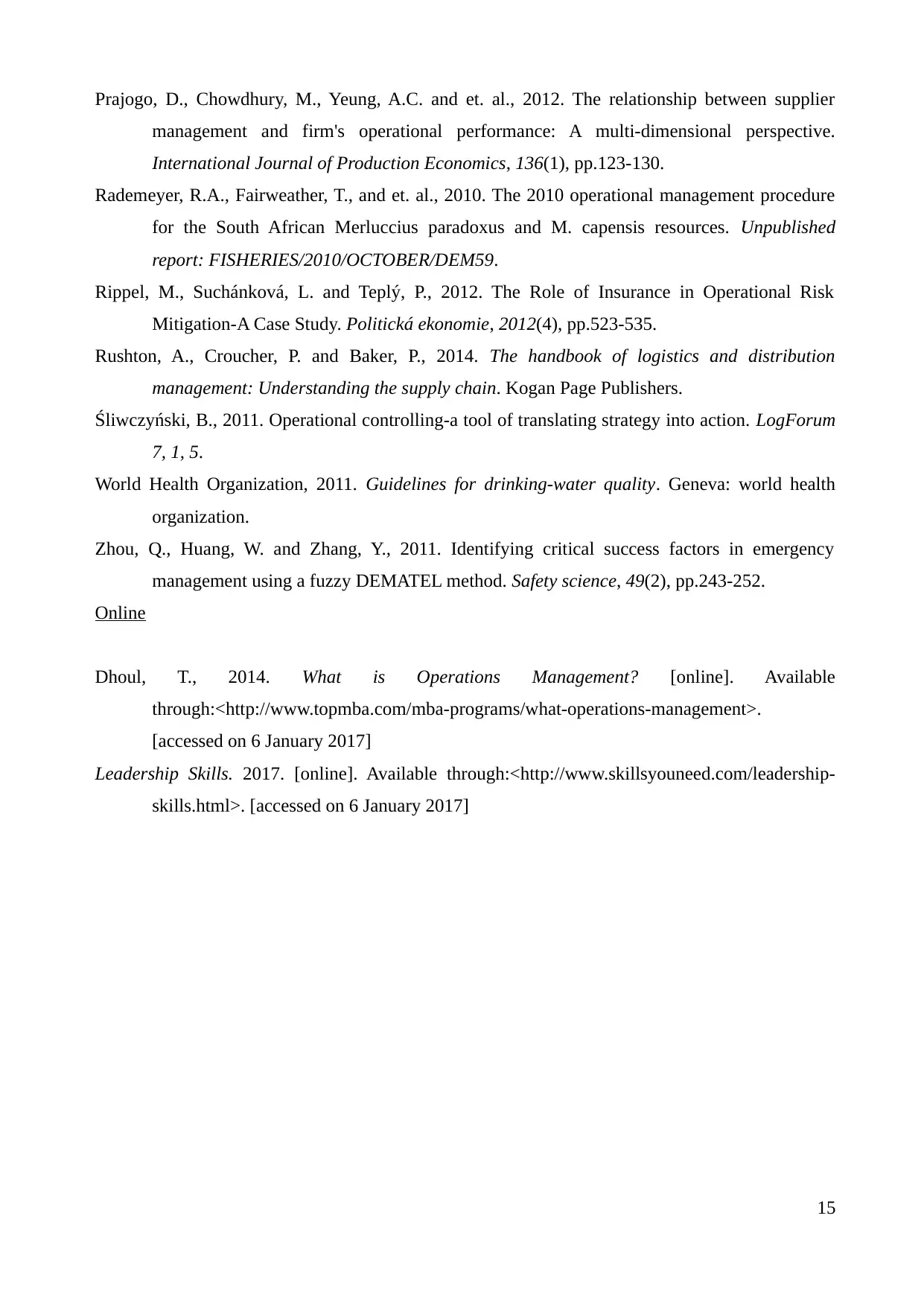
Prajogo, D., Chowdhury, M., Yeung, A.C. and et. al., 2012. The relationship between supplier
management and firm's operational performance: A multi-dimensional perspective.
International Journal of Production Economics, 136(1), pp.123-130.
Rademeyer, R.A., Fairweather, T., and et. al., 2010. The 2010 operational management procedure
for the South African Merluccius paradoxus and M. capensis resources. Unpublished
report: FISHERIES/2010/OCTOBER/DEM59.
Rippel, M., Suchánková, L. and Teplý, P., 2012. The Role of Insurance in Operational Risk
Mitigation-A Case Study. Politická ekonomie, 2012(4), pp.523-535.
Rushton, A., Croucher, P. and Baker, P., 2014. The handbook of logistics and distribution
management: Understanding the supply chain. Kogan Page Publishers.
Śliwczyński, B., 2011. Operational controlling-a tool of translating strategy into action. LogForum
7, 1, 5.
World Health Organization, 2011. Guidelines for drinking-water quality. Geneva: world health
organization.
Zhou, Q., Huang, W. and Zhang, Y., 2011. Identifying critical success factors in emergency
management using a fuzzy DEMATEL method. Safety science, 49(2), pp.243-252.
Online
Dhoul, T., 2014. What is Operations Management? [online]. Available
through:<http://www.topmba.com/mba-programs/what-operations-management>.
[accessed on 6 January 2017]
Leadership Skills. 2017. [online]. Available through:<http://www.skillsyouneed.com/leadership-
skills.html>. [accessed on 6 January 2017]
15
management and firm's operational performance: A multi-dimensional perspective.
International Journal of Production Economics, 136(1), pp.123-130.
Rademeyer, R.A., Fairweather, T., and et. al., 2010. The 2010 operational management procedure
for the South African Merluccius paradoxus and M. capensis resources. Unpublished
report: FISHERIES/2010/OCTOBER/DEM59.
Rippel, M., Suchánková, L. and Teplý, P., 2012. The Role of Insurance in Operational Risk
Mitigation-A Case Study. Politická ekonomie, 2012(4), pp.523-535.
Rushton, A., Croucher, P. and Baker, P., 2014. The handbook of logistics and distribution
management: Understanding the supply chain. Kogan Page Publishers.
Śliwczyński, B., 2011. Operational controlling-a tool of translating strategy into action. LogForum
7, 1, 5.
World Health Organization, 2011. Guidelines for drinking-water quality. Geneva: world health
organization.
Zhou, Q., Huang, W. and Zhang, Y., 2011. Identifying critical success factors in emergency
management using a fuzzy DEMATEL method. Safety science, 49(2), pp.243-252.
Online
Dhoul, T., 2014. What is Operations Management? [online]. Available
through:<http://www.topmba.com/mba-programs/what-operations-management>.
[accessed on 6 January 2017]
Leadership Skills. 2017. [online]. Available through:<http://www.skillsyouneed.com/leadership-
skills.html>. [accessed on 6 January 2017]
15
1 out of 15
Related Documents
Your All-in-One AI-Powered Toolkit for Academic Success.
+13062052269
info@desklib.com
Available 24*7 on WhatsApp / Email
![[object Object]](/_next/static/media/star-bottom.7253800d.svg)
Unlock your academic potential
© 2024 | Zucol Services PVT LTD | All rights reserved.





